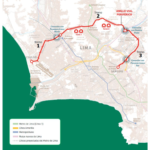Basic requirment of the bridge under design
Choosing the right location is crucial for designing and planning a bridge. But above all, safety considerations that govern the technical, functional, economic, efficiencies, expeditiousness, and aesthetic requirements are very important. It is necessary for the bridge and each of its components to be safe, durable, reliable, and stable. This is usually checked by analysis using current specifica-tions. But not all questions of durability, reliability, and stability may be answered by analysis.
Therefore, in some cases it is necessary to provide special measures such as testing the performance of the structure and examining its behavior under maximum loading on the construction site.
Specifications and technical requirements should be satisfied because they guarantee the carrying capacity of the structure. From the safety point of view, all bridges designed according to the technical requirements are equal. But practically speaking, different aspects of technical requirements may be satisfied with different margins of safety.
Regarding the various bridge components, it is necessary to know that for engineering structures, the best solution should provide the appropriate material and carrying capacity.
During comparison of projects, the technical requirements should be considered. Because technical requirements may be accomplished using alternatives, consideration should always be given to additional guarantees for safety. Never compromise the safety of the passengers. Essential requirements naturally should have great importance, but they are basically satisfied by accepted clearance. Also, additional consideration must be given to issues other than elementary demands in order to make traffic flow efficiently. Note that the height of the bridge and the elevation of the roadway must be determined at an early stage, because they have influence on the traffic flow. Also, greater or smaller grades of the approaches should be designed earlier in the project. Maximum grades are defined by specifications, but for practical purposes minimum grades are the most convenient. Further, it is important to define the number of joints in the roadway that correlate to the division of the structure in separate sections.
Conditions of minimum wear of the parts of carrying construction under the influence of moving vehicles are also important to consider. Regarding the maintenance of the roadway and the bridge, it is possible to consider this as a general expense and therefore relate it to economic considerations.
Essential requirements indicate that the total cost of the bridge at all conditions should be economically rational. The overall cost of construction and bridge erection is determined in significant part by the quantity of material and the unit price. Yet, the tendency to reduce the quantity of material in order to achieve lower cost does not always lead to minimum overall cost. There are other factors that should be taken into consideration. Take, for example, steel structures: consideration should be given to quantity of steel and on top of that special attention must be given to modern industrial practices in production which in its turn may lead to conveniences in erection resulting from heavy construction with lower cost.
During comparisons of various projects, analysis of their economic criteria may reveal principles of expedience that can be applied to the project under consideration. Construction requirements are connected to economic constraints because, when the amount of material is small, the work is simple and the time required is shorter. Also, the unit price is considered as part of the economic criteria, which implies the cost of preparation and erection. All these factors affect the overall cost.
For conventional bridges to be built from a certain material, construction is carried out by established methods. Therefore, during comparison of alternatives, construction criteria are not so important. In special cases of complicated erection of bridges having large spans, or for urgent work, construction requirements are very important and may influence the choice of the bridge system and material. In these cases, it may be necessary to use a great quantity of materials, thus increasing the cost of construction and ignoring other requirements. For example, during the initial period of application, assembled reinforced-concrete constructions were more expensive than monolithic ones. However, with increased use of these constructions, the application of assembled structures is more rational and economical.







